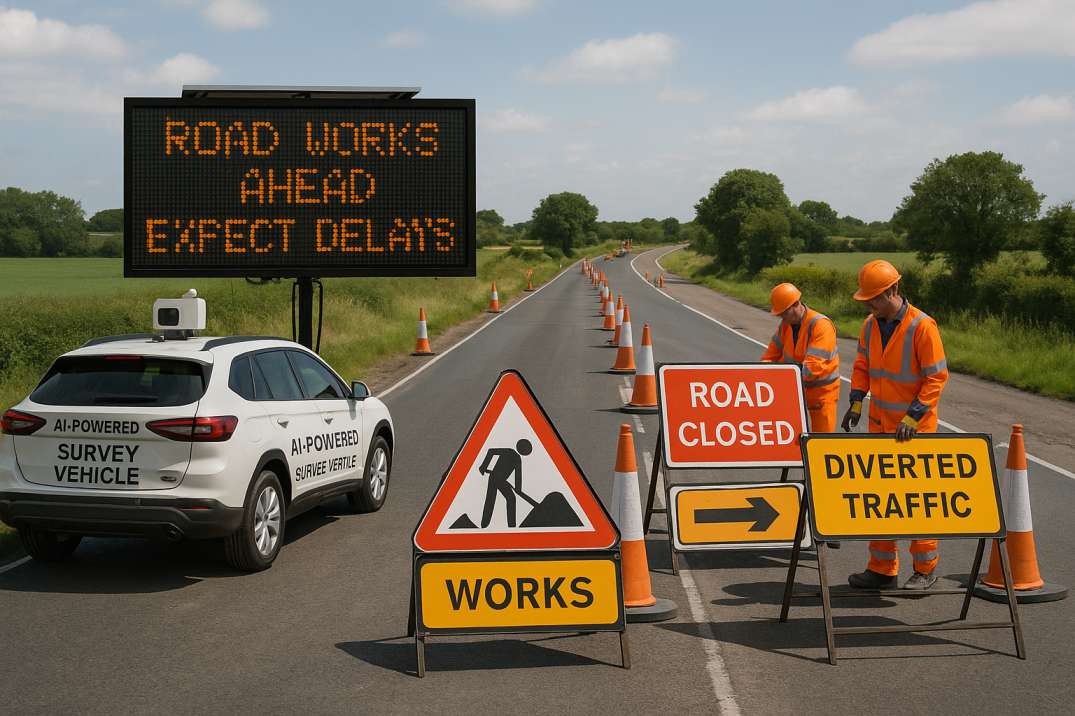Contact Us
RoadVision AI
Private Limited
Office No. 308 & 310, B Block
Ansal Chamber - 1, Bhikaji Cama Place,
Near Engineers India Limited (EIL) Bhawan, New Delhi - 110066
© 2024 | RoadVision AI | All rights reserved
In India and globally, the planning of road diversions, signage placement, and traffic control measures has historically followed manual, experience-based processes. While the IRC SP 55 guideline offers a foundational framework for traffic control and safety during road works, it was never designed for today’s dynamic and complex traffic conditions. Enter AI-based road management and road asset management India solutions—technologies poised to revolutionize how diversions and signage are planned, validated, and implemented.
The IRC SP 55:2014 guideline from the Indian Roads Congress outlines procedures for traffic control devices, road diversions, temporary signage, and safety measures during construction and maintenance. It standardizes how work zones should be marked and managed.
But IRC SP 55 is static. It doesn't adapt in real time, nor does it optimize decisions based on contextual traffic data, behavior analytics, or accident risk patterns. This is where AI road management can push the boundaries.

While IRC SP 55 ensures a baseline level of safety, it assumes one-size-fits-all planning. Issues with this approach include:
With increasing vehicle density, urban complexity, and infrastructure fatigue, these shortcomings can be costly.
AI-based road asset management platforms like RoadVision AI bring automation, accuracy, and analytics to what was once guesswork.
AI uses high-resolution camera feeds, LiDAR, GPS data, and machine learning models to:
Explore their Pavement Condition Survey tools and Road Inventory Inspection services to understand how AI captures fine-grained data.
In traditional Road Safety Audits, compliance with IRC SP 55 often meant visual checks. Now, with AI-powered road safety audit tools like those from RoadVision, audits are enriched with:
Rural road diversions often get the least planning attention. But AI helps bridge the gap with:
This approach aligns with principles in IRC:82-2015, which emphasizes early detection of defects and preventive maintenance for bituminous roads. AI ensures these maintenance activities come with planned signage and safe detours.
It’s important to note that AI doesn't replace IRC SP 55 compliance. Rather, it enhances it. Agencies can use AI to:
This enables a shift from “tick-box compliance” to performance-driven road safety.
AI-powered systems are transforming how roads are maintained and navigated during construction or repair. Moving beyond IRC SP 55, AI in road management enables safer, smarter, and more sustainable traffic control strategies.
RoadVision AI is transforming infrastructure development and maintenance by harnessing artificial intelligence and computer vision AI to revolutionize road safety and management. By leveraging advanced computer vision artificial intelligence and digital twin technology, the platform enables the early detection of potholes, cracks, and other road surface issues, ensuring timely repairs and better road conditions. With a mission to build smarter, safer, and more sustainable roads, RoadVision AI tackles challenges like traffic congestion and ensures full compliance with IRC Codes. By empowering engineers and stakeholders with data-driven insights, the platform reduces costs, minimizes risks, and enhances the overall transportation experience.
India’s road sector is rapidly evolving, and to lead this transformation, planners and policymakers must embrace AI for road asset management. Solutions like RoadVision AI provide a scalable way to digitize compliance, maximize road user safety, and optimize diversion logistics.
Want to experience intelligent road diversion planning firsthand?
Book a demo with us and see how AI can transform your projects.
Q1. Is IRC SP 55 still relevant with AI systems?
Yes, IRC SP 55 sets the regulatory foundation. AI enhances compliance and updates it in real time based on actual road usage data.
Q2. How does AI help in work zone safety?
AI maps risks, simulates traffic flows, and suggests precise signage plans, improving safety for both workers and drivers.
Q3. Can AI systems work in rural road environments?
Absolutely. With satellite and edge data capture, AI can function even in low-connectivity regions.